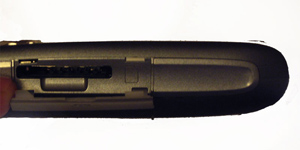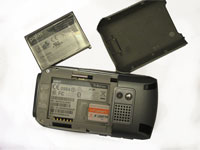Internet
The Treo 680 sports Class 10 GPRS and EDGE, just like the Treo 650. Edge isn't as fast as HSDPA/UMTS or EV-DO (definitions), but it's ubiquitous -- for example, Cingular claims 13,000 cities and towns and 44,000 miles of highway, and EDGE is several times faster than dialup. With the increased RF signal of the antenna, data speeds will likely be just slightly better than the 650's, but these speed increases will be nothing to write home about.
The email application (formerly known as VersaMail) is dead-simple to set up. If you have one of the common ISPs or email addresses, odds are very good that you can just select your ISP, type in your email address and password, and start checking your email. It is very simple and ridiculously easy to use. It is simple to the point where it doesn't require an IT department to set up, which is a pleasure.
If your ISP isn't on the list, your ISP should be able to provide you with a little cheat sheet that you can use to configure your email and server information.
It is worth noting that the email application on the 680 doesn't support Exchange Push email. If you want push email, you will need to use a client like Good -- an installer for that can be found in the main applications menu.
The Phone Application
On the Treo 650, the Phone application was a bit of a user interface mess -- you scrolled down to get past the 4 favorites, and then you could scroll several pages right. The dial pad was too small to use predictably, and there wasn't enough screen real estate to make it fully useful. It was difficult to get messages, calendar appointments, a dial pad, and favorites on the screen.
On the Treo 680, they solve this formerly broken user interface problem with tabs. There are 5 main tabs at the bottom: dial pad, a favorites page that scrolls down, a main "Today" page that shows unread messages and upcoming events, a Contacts page (which formerly had its own app), and a Call Log page (this was present in the 650 but not intuitive to find). The UI is simple, vastly more powerful, and is a very welcome update. The dial pad numbers are larger -- plenty large for my fingers to use. These changes to the phone app, while subtle, really brings the phone aspect of the Treo into its own.
It is worth noting that the favorites page is limited only by the amount of memory in the Treo itself -- if 5 pages of favorites wasn't enough for you with the 650, you should be fine for a while.
(Click images for full size)
Camera
The 0.3 MegaPixel VGA camera (640x480) on the 680 has the same specifications as the camera on the Treo 650, yet it is improved. The Treo 680 camera fixes some of the defects that were present in the Treo 650 camera -- such as blue ghosting and poor low-light response. Both adjust their lighting automatically, but the 680 yields clearer pictures.
It's not a camera that Bob Gruen or Ansel Adams would get excited about, but it's enough to assign pictures to contacts and capture random moments. I have to say, it's unfortunate that Palm didn't update the camera. The 700p, Palm's upgrade path for Treo 650 users on CDMA, has a 1.3 MP camera. Feature phones are starting to sport 2.0 MP cameras already.
Storage
The Treo 680, like the Treo 650 before it, uses non-volatile RAM to store information, which means that you won't lose all of your data if the device runs out of batteries.
The Treo 680 ships with 64 MB of free user space, a marked improvement over the Treo 650's 23 MB of free space. This free space gives a user much more room to store applications, pictures, games, camera pictures, and videos. The phone also has 64MB of non-user-accessible SDRAM for running the PalmOS and programs.
SD Memory Expansion Cards

The Treo 680 is compatible with SD memory expansion cards, and will support a card of up to 2GB in size for additional file storage. The SD card storage area has been moved from the top of the phone to the right side, with a little flap that covers the SD card. This may make SDIO devices such as the Novii Remote Blaster slightly more difficult to use with the Treo 680, but it does have the benefit of keeping a memory card more secure -- people often lose their memory cards if they drop the Treo 650 or 600, as there's nothing but a spring keeping the memory cards in place. The movement of the SD card slot also fixes a common issue with holsters involving SD cards. As with all PalmOS Treos, the SDIO slot doesn't support wifi cards.
Other Hardware

Cable Connector
The Treo 680 uses the same connector as the Treo 650 -- Palm refers to it as their "Multi-Connector." As with the 750v, the HotSync cable no longer has a space for the power plug; they now sit side-by-side.
Sim Card Tray

The SIM Card tray is now locked away in a slide-out tray beneath the Treo. If you do a lot of SIM Card swapping, this may annoy you. If you used a Treo 650 and lost your SIM Card tray after dropping your Treo, this will be a welcome addition. Regardless, the 680's SIM card is held securely.
Battery
The 680 form factor redesign limited the size of the battery. The GSM Treo 650 used a larger 1800 MAh battery, which offered 6 hours of talk time and 300 hours of standby. The 680 uses a 1200MAh battery, which will provide 4 hours of talk time with 300 hours of standby. Let's just say that I don't expect this to be one of the selling points of the 680. This may well prevent some Treo 650 power users from upgrading to this device. My testing indicates that the Treo 650 battery fits in the 680, though it requires duct tape or perhaps a new battery cover. Please note that the 680 battery warns of explosion should you try something like this. In all seriousness, a car charger and maybe an extra wall charger may be wise investments.

Next Page: Software and Loose Ends
>>